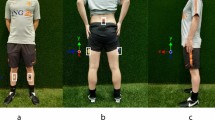Abstract
In this paper a method is presented to determine force-length relations of in-vivo human skeletal muscles. The method is experimental and can be used for selected multi-joint muscles. It contains three basic assumptions: (a) the maximal, isometric force a muscle can exert is constant for a given muscle length, (b) antagonistic muscle activity for the experimental contractions is constant, and (c) resultant joint moments obtained during the experiments are produced by muscular forces exclusively. Experimentally determined force-length relations of intact in-vivo human skeletal muscles have not been determined yet. Application of this method will allow the comparison of actual force-length relations of selected human skeletal muscles to force-length relations used previously. Proposed mechanisms responsible for the force-length characteristics of a muscle, such as the cross-bridge theory, may be critically evaluated. Differences of force-length relations obtained under in vivo and in vitro conditions may be quantified.
Similar content being viewed by others
References
Benedict JV, Walker LB, Harris EH (1968) Stress-strain characteristics of unembalmed human tendon. J Biomech 1:53–63
Blix M (1891) Die Laenge und die Spannung des Muskels. Skand Arch Physiol 3:295–318
Blix M (1893) Die Laenge und die Spannung des Muskels. Skand Arch Physiol 4:399–409
Blix M (1894) Die Laenge und die Spannung des Muskels. Skand Arch Physiol 5:149–206
Cecchi GF, Lombardi V (1976) The relation between sarcomere length and isometric tetanic tension of isolated frog muscle fibers at 20°C. Boll Soc Ital Biol Sper 52:716–718
Fabiato A, Fabiato F (1978) Myofilament-generated tension oscillations during partial calcium activation and activation dependence of the sarcomere length-tension relation of skinned cardiac cells. J Gen Physiol 72:667–699
Frigo C, Pedotti A (1978) Determination of muscle length during locomotion. Biomechanics VI-A. University Park Press Baltimore, pp 355–360
Gordon AM, Huxley AF, Julian FJ (1966a) Tension development in highly stretched vertebrate muscle fibres. J Physiol (Lond) 184:143–169
Gordon AM, Huxley AF, Julian FJ (1966b) The variation in isometric tension with sarcomere length in vertebrate muscle fibres. J Physiol (Lond) 184:170–192
Grieve DW, Pheasant S, Cavanagh PR (1978) Prediction of gastrocnemius length from knee and ankel posture. Biomechanics VI-A. University Park Press Baltimore, pp 405–412
Hatze H (1981) Estimation of myodynamic parameter values from observations on isometrically contracting muscle groups. Eur J Appl Physiol 46:325–338
Hellam DC, Podolsky RJ (1969) Force measurements in skinned muscle fibres. J Physiol (Lond) 200:807–819
Herzog W (1988a) Determination of muscle model parameters using an optimization technique. Biomechanics X-B 20:1175–1179
Herzog W (1988b) The relation between the resultant moments at a joint and the moments measured by an isokinetic dynamometer. J Biomech 21:5–12
Huxley AF (1957) Muscle structure and theories of contraction. Prog Biophys Biophys Chem 7:255–318
Julian FJ, Moss RL (1980) Sarcomere length tension relations of frog skinned muscle fibres at lengths above the optimum. J Physiol (Lond) 304:529–539
Kulig K, Andrews JG, Hay JG (1984) Human strength curves. Exercise and sport sciences reviews. Collamore Press, Lexington MA 12:417–466
Pierrynowski MR (1982) A physiological model for the solution of individual muscle forces during normal human walking. Ph. D. Thesis, Simon Fraser University, Vancouver, BC
Schoenberg M, Podolsky RJ (1972) Length-force relation of calcium activated muscle fibers. Science 176:52–54
Steindler A (1977) Kinesiology of the human body. Thomas Springfield ILL
ter Keurs HEDJ, Iwazumi T, Pollack GH (1978) The sarcomere length-tension relation in skeletal muscle. J Gen Physiol 72:565–592
Walker SM, Randolph-Schrodt G (1973) I-segment lengths and thin filament periods in skeletal muscle fibers of the Rhesus monkey and the human. Anat Rec 178:63–82
Yamada H (1970) Strength of biological materials. Williams & Wilkins Baltimore
Author information
Authors and Affiliations
Rights and permissions
About this article
Cite this article
Herzog, W., ter Keurs, H.E.D.J. A method for the determination of the force-length relation of selected in-vivo human skeletal muscles. Pflugers Arch. 411, 637–641 (1988). https://doi.org/10.1007/BF00580859
Received:
Revised:
Accepted:
Issue Date:
DOI: https://doi.org/10.1007/BF00580859




